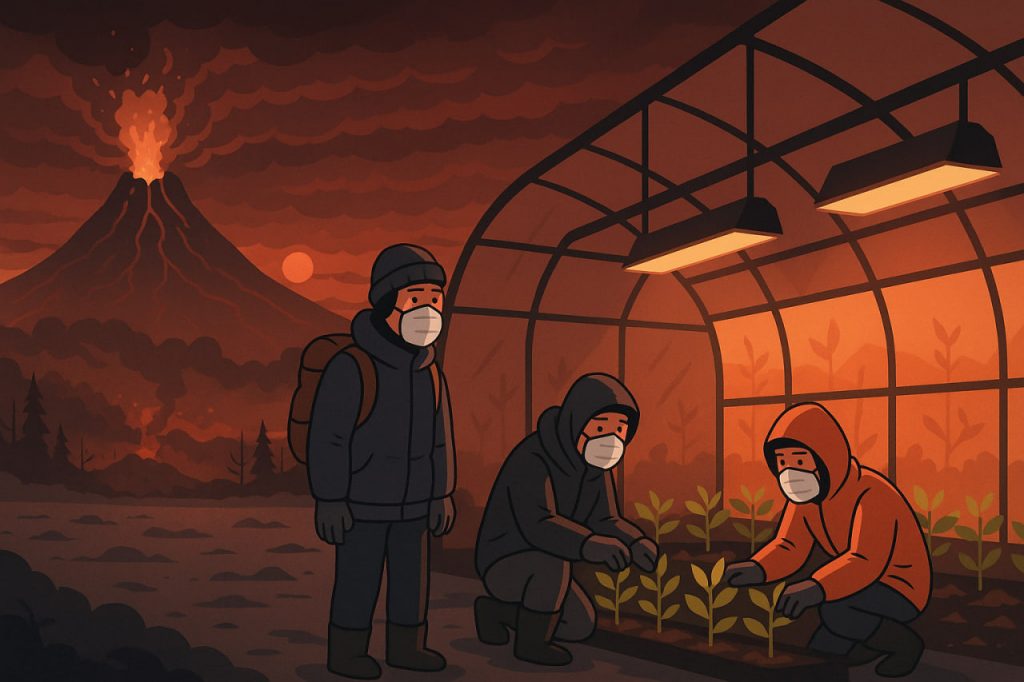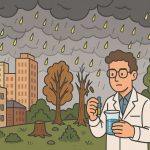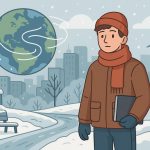A volcanic winter is one of the most dramatic natural disasters that could affect life on Earth. Unlike a nuclear winter caused by war, a volcanic winter occurs when an enormous volcanic eruption releases so much ash, sulfur dioxide, and aerosols into the atmosphere that sunlight is blocked for months or even years. The result is a sudden and severe global cooling, with falling temperatures, crop failures, and disruptions to ecosystems worldwide. Scientists have found evidence that such events have changed the course of human history before — and could do so again.
What Is a Volcanic Winter?
When a supervolcano or series of major eruptions occur, they can inject tens or hundreds of millions of tons of sulfate aerosols into the stratosphere. These tiny particles reflect sunlight back into space, drastically reducing the amount of heat that reaches the surface.
Unlike typical volcanic ash that settles quickly, these aerosols can remain aloft for years, cooling the planet by several degrees.
Historical records show how powerful these events can be:
- The Tambora eruption (1815) in Indonesia caused “The Year Without a Summer” — leading to global food shortages and freezing weather even in June.
- The Krakatoa eruption (1883) dimmed sunlight worldwide and created vivid red sunsets for months.
- Around 74,000 years ago, the Toba supervolcano erupted, possibly reducing global temperatures by up to 10°C, nearly driving early humans to extinction.
How a Volcanic Winter Would Unfold Today
If a major eruption occurred in our modern world — such as Yellowstone in the U.S. or Toba in Indonesia — its effects would ripple across the globe:
- Immediate Atmospheric Changes
Within weeks, skies would darken worldwide as sunlight is blocked. The planet could cool by several degrees in just a few months. Daylight might look orange or dim, and average global temperatures could drop by 5–8°C for several years. - Agricultural Collapse
Reduced sunlight would devastate crops, shortening growing seasons or killing plants entirely. Major food-producing regions in North America, Europe, and Asia would face widespread famine. Prices of basic goods would skyrocket, and food scarcity could trigger social unrest. - Oceanic and Ecological Shifts
Cooler oceans would alter currents and weather systems, potentially halting monsoons and changing rainfall patterns. Many species could struggle to survive sudden habitat changes, leading to biodiversity loss and food chain disruptions. - Air Quality and Health Risks
Ash and sulfuric aerosols could make the air hazardous to breathe, especially near eruption zones. Acid rain would contaminate freshwater supplies and soil, damaging infrastructure and crops.
What Humanity Could Do to Survive
While we can’t prevent a volcanic winter, preparation and adaptation could significantly improve survival chances.
- Global Monitoring and Early Warning
Organizations like the Global Volcanism Program and NASA already monitor volcanic activity using satellites. Advanced early warning systems could help governments react faster — closing airports, protecting water supplies, and securing food reserves. - Food and Energy Security
- Stored grain reserves would be critical to sustain populations through dark years.
- Greenhouse farming with artificial lighting (powered by geothermal or nuclear energy) could produce food even in dim conditions.
- Algae and fungi cultivation could provide alternative protein sources with minimal sunlight.
- International Cooperation
A volcanic winter would be a global event, requiring cooperation on resource distribution, trade, and humanitarian aid. Countries with milder effects could help others facing famine or freezing conditions. - Climate Engineering Experiments
Some scientists propose injecting particles into the atmosphere to cool Earth intentionally (solar geoengineering). In the reverse case of volcanic winter, humanity might try to warm the planet artificially, though such actions would carry enormous risks and uncertainties. - Protection of Ecosystems and Seed Banks
Facilities like the Svalbard Global Seed Vault and genetic repositories would ensure humanity can replant and restore food systems when sunlight returns.
How Long Would It Last?
A volcanic winter could last from one to ten years, depending on the eruption’s magnitude and atmospheric conditions. Global recovery of temperatures might take decades, and social recovery could take even longer.
Could a Volcanic Winter Happen Soon?
While catastrophic eruptions are rare, they are not impossible. Geological evidence suggests super-eruptions occur roughly once every 50,000 to 100,000 years. Several volcanoes, including Yellowstone (USA), Campi Flegrei (Italy), and Taupō (New Zealand), remain under close observation for potential large-scale activity.
Lessons from the Past
Humanity has survived smaller volcanic winters before — through adaptation, migration, and innovation. Today’s global communication and technology could give us an advantage, but survival would still depend on international unity, resource management, and scientific foresight.
Interesting Facts
- The 1815 Tambora eruption lowered global temperatures by about 3°C, causing famines in Europe and China.
- Volcanic winters can also create beautiful sunsets due to light scattering by aerosols.
- Some scientists believe volcanic winters have redirected human evolution by forcing early humans to adapt to colder climates.
- Modern aircraft can help study volcanic plumes, improving future predictions.
- Even medium-sized eruptions can affect climate if multiple occur within a decade.
Glossary
- Aerosols — tiny particles suspended in the air that reflect sunlight.
- Supervolcano — a volcano capable of erupting over 1,000 cubic kilometers of material.
- Acid rain — rain with high acidity due to atmospheric sulfur dioxide.
- Geoengineering — deliberate modification of the Earth’s climate system.
- Stratosphere — the second layer of the atmosphere, where volcanic particles can stay for years.


